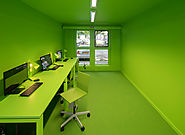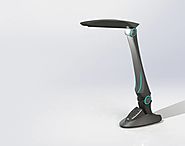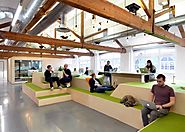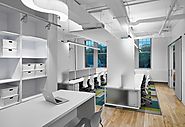-
About
- About Listly
- Community & Support
- Howto
- Chrome Extension
- Bookmarklet
- WordPress Plugin
- Listly Premium
- Privacy
- Terms
- DMCA Copyright
- © 2010-2024 Boomy Labs


 Workopolis_for_employers
Workopolis_for_employers
Listly by Workopolis_for_employers
We all love drooling over the gorgeous pics of Google's and Facebook's HQ's – but not every workplace can afford to keep an interior designer on retainer. Luckily, there are a lot of smaller – but impactful! – things you can do to make your office look incredible (and, in turn, keep your team happy and productive). Feel free to add your own ideas to the list!

When it comes to an office environment, the impact of bold colour is incredibly powerful. A splash of a bright hue on the wall, floor, or desk can mean the difference between a successful brainstorming session and an unproductive one; it can boost an employee’s confidence before a big meeting; and it can even make workers more detail-oriented.
Green, for example – shown here in architecture firm MVRDV's Rotterdam office – is linked to broad, creative thought, and heightened productivity.

At CES 2017, the new office launches were all about making employees happy, healthy, and more engaged.
Lumigent by Cerevo, for example, responds to voice commands to change LED brightness levels and positions – and can even memorize various preferences to suit a user’s individual tasks. It also features an integrated autofocus eight-megapixel camera, and can snap pictures and shoot video on command.

Whether your office is 1,500 square metres or 15,000, breakout spaces are integral to an energized, creative workplace. Giving employees casual areas to collaborate and brainstorm – or even just get away from their desk for an hour or so – is crucial to their productivity and well-being.
At Airbnb's London office, for example, a series of environments inspired by traditional English settlements – like The library and The Market Square – provide a diverse range of work areas for its employees. The aptly-named Village Green is designed to be an informal working hub for workers to sit, lounge and lie on. Plus, it looks like a cool sculpture when not in use.

Once upon a time, even the lowliest worker had some private space at the office, albeit via drab partitions that sectioned off employees with just enough space for a desk and chair: the cubicle. By the start of the 21st century, forward-looking companies were doing away with confining cubicles altogether in lieu of open-plan offices.
Both had their challenges, and more recently, Japanese furniture manufacturer Okamura has been fine-tuning an office furniture collection that sits somewhere in between. The Muffle collection is comprised of seating, tables, and other furniture, but the core of the collection is a series of boldly-hued (and sound-absorbing) panels at varying heights that curve around workstations and seating areas – a kind of modern take on the cubicle.

“Sitting is the new smoking.” We’ve all heard it again and again. The mantra that had trend-setting offices all over adopting standing desks, workplace sensors, and walking meetings. But not everyone can stand all day. Not everyone can stand for even a short period of time, for that matter, and get any work done.
Here’s another possible solution: healthy sitting. Flip Flap by Itoki, for example, is specially designed to support – and encourage – virtually any kind of movement an office worker might want to engage in while at their desk. The design, inspired by origami, has a lot of moving components, including side lumbar support cushions and a recline of up to 135 degrees – meaning you can take the chair to a near-horizontal position for a little mid-day “healthy sitting nap” (yes, we just coined a phrase).

For small but growing companies, modular, flexible furniture is crucial to getting the most out of every square centimetre of an office space – especially in shared areas that might do double or triple duty (a.k.a. breakout space-slash-reception-slash-meeting room).
A great example of this is Austrian furniture maker Bene, which launched a customizable furniture system called Pixel at Milan Design Week 2017. The collection is essentially a series of wooden boxes and metal frames that combine to make seating, storage, tables, platforms, and more – and they can be switched around and re-stacked at a moment’s notice.

As workforces become increasingly blended with a range of full-time, part-time, contract, and remote workers, many companies are looking to unassigned workstations to make the most of their office space.
“On any given day, around 60 per cent of desks are empty,” explains Robyn Baxter of HOK Canada, a global architecture firm. “We know 20 per cent of them have signs that somebody is sitting there that day; they’re just away at the moment. But 40 per cent of the time, there’s no sign of life – nobody is sitting at that desk on that day.” It begs the question: with the rising cost of real estate, why spend money on space, heating, and lighting when there’s nobody there to use it?
Hot desks – that is, unassigned desks that are available for use by anyone who needs one – are a way to use space more efficiency when people don’t regularly occupy the same spot.

Open concept might boost collaboration and communication, but it can also mean extra distractions, reduced productivity, and a lot more noise. In short, a lack of office privacy is a problem. Luckily, there are lots of products designed to reduce noise and create moments of calm in the ever-bustling modern workplace.
Zilenzio's Focus divider, for example, is a simple and flexible way to create personal space. Available in seven sizes, in floor and desk versions, the divider can even be rolled up and tucked away when not in use.
